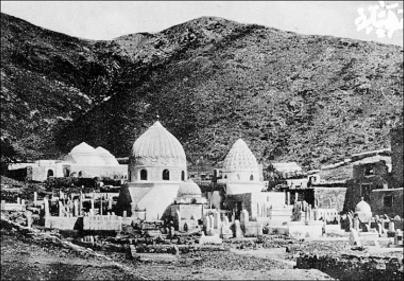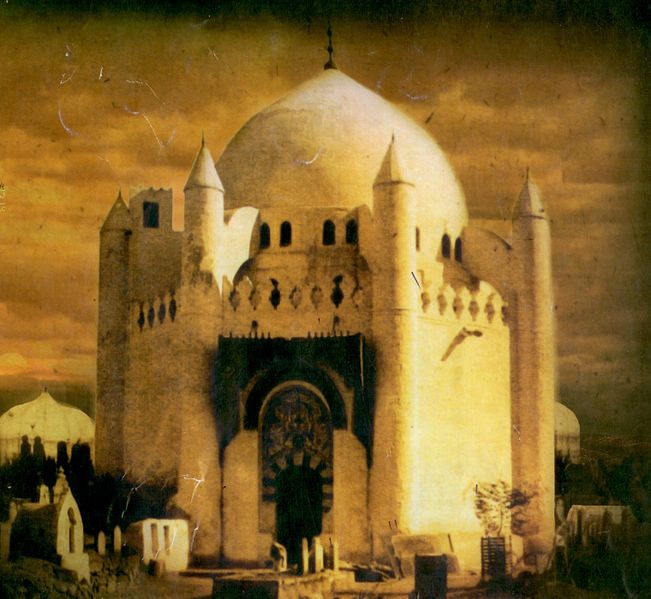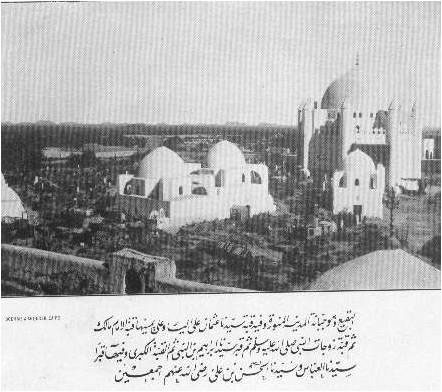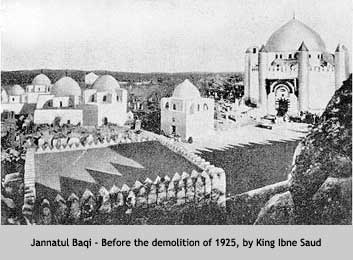
|
|
HISTORY OF THE CEMETERY OF JANNATHUL BAQI WHERE HOLY IMAM HASAN (pbuh) (2ND IMAM), HOLY IMAM ZAINUL ABIDEEN (pbuh) (4TH IMAM), HOLY IMAM MUHAMMAD BAQIR (pbuh) (5TH IMAM), & HOLY IMAM JA'FAR SADIQ (pbuh) (6TH IMAM), ARE BURIED On 8th Shawwal, Wednesday, in the year 1345 AH (April 21, 1925), mausoleums in Jannatul al-Baqi (Madina) were demolished by King Abdul Aziz Ibn Saud of Saudi Arabia. In the same year (1925), he also demolished the tombs of holy personages at Jannat al-Mualla (Makkah) where the Holy Prophet's mother, wife, grandfather and other ancestors are buried. This happened despite protest by the International Islamic community The destruction of sacred sites in Hijaz initiated by the Saudi Wahhabi Muhammad ibn Abdul Wahab continues even today. According to some scholars what is happening in Hijaz is actually a conspiracy plotted by the Jews against Islam, under the guise of Tawheed. The idea is to eradicate the Islamic legacy and heritage and to systematically remove all its vestiges so that in the days to come, Muslims will have no affiliation with their religious history. The Origins of Al-Baqi Literally "al-Baqi" means a tree garden. It is also known as "Jannat al-Baqi" due to its sanctity, since in it are buried many of our Prophet's relatives and companions. The first companion buried in al-Baqi was Uthman b. Madhoon who died on the 3rd of Sha'ban in the 3rd year of Hijrah. The Holy Prophet (pbuh) ordered certain trees to be felled, and in its midst, he buried his dear companion, placing two stones over the grave. On the following years, the Holy Prophet's (pbuh) son Ibrahim, who died in infancy and over whom the Holy Prophet (pbuh) wept bitterly, was also buried there. The people of Madina then began to use that site for the burial of their own dead, because the Holy Prophet (pbuh) used to greet those who were buried in al-Baqi by saying, "Peace be upon you, O abode of the faithful! God willing, we should soon join you. O' Allah, forgive the fellows of al-Baqi". The site of the burial ground at al-Baqi was gradually extended. Nearly seven thousand companions of the Holy Prophet (pbuh) were buried there, not to mention those of the Ahlul Bayt (a.s). The Holy Imam Hasan (a.s) (pbuh), The Holy Imam Zainul Abideen (a.s) (pbuh), The Holy Imam Muhammad al-Baqir (a.s) (pbuh), and The Holy Imam Ja'far al-Sadiq (a.s) (pbuh) were all buried there. Among other relatives of the Holy Prophet (saw) who were buried at al-Baqi are: His aunts Safiya and Aatika, and His aunt Fatima bint al-Asad, the mother of Holy Imam Ali (a.s). The third caliph Uthman was buried outside al-Baqi, but with later extensions, his grave was included in the area. In later years, great Muslim scholars like Malik bin Anas and many others, were buried there too. Thus, did al-Baqi become a well-known place of great historic significance to all Muslims. Al-Baqi as viewed by historians Umar bin Jubair describes al-Baqi as he saw it during his travel to Madina, saying "Al-Baqi is situated to the east of Madina. You enter it through the gate known as the gate of al-Baqi. As you enter, the first grave you see on your left is that of Safiya, the Holy Prophet's (saw) aunt, and further still is the grave of Malik bin Anas, the Imam of Madina. On his grave is raised a small dome. In front of it is the grave of Ibrahim son of our Holy Prophet (saw) with a white dome over it, and next to it on the right is the grave of Abdul-Rahman son of Umar bin al-Khattab, popularly known as Abu Shahma, whose father had kept punishing him till death overtook him. Facing it are the graves of Aqeel bin Abi Talib and Abdullah bin Ja'far al-Tayyar. There, facing those graves is a small shrine containing the graves of the Holy Prophet's (saw) wives, following by a shrine of Abbas bin Abdul Muttalib. The grave of Holy Imam Hasan bin Ali (a), situated near the gate to it's right hand, has an elevated dome over it. His head lies at the feet of Abbas bin Abdul Muttalib, and both graves are raised high above the ground, their walls are panelled with yellow plates and studded with beautiful star-shaped nails. This is how the grave of Ibrahim, son of the Holy Prophet (saw) has also been adorned. Behind the shrine of Abbas there is the house attributed to Fatima, daughter of our Holy Prophet (ssw), known as "Bayt al-Ahzaan" (the house of grief) because it is the house she used to frequent in order to mourn the death of her father, the chosen one, peace be upon him. At the farthest end of al-Baqi is the grave of the caliph Uthman, with a small dome over it, and there, next to it, is the grave of Fatima bint Asad, mother of Ali b. Abi Talib (a.s)" After a century and a half, the famous traveller Ibn Batuta came to describe al-Baqi in a way which does not in any way differ from the description given by Ibn Jubair. He adds saying, "At al-Baqi are the graves of numerous Muhajirin and Ansar and many companions of the Holy Prophet (saw), except that most of their names are unknown." Thus, over the centuries, al-Baqi remained a sacred site with renovations being carried out as and when needed till the Wahhabis rose to power in the early nineteenth century. The latter desecrated the tombs and demonstrated disrespect to the martyrs and the companions of the Holy Prophet (saw) buried there. Muslims who disagreed with them were branded as "infidels" and were subsequently killed. The First Destruction of Al-Baqi The Wahhabis believed that visiting the graves and the shrines of the Holy Prophets, the Imams, or the saints was a form of idolatry and totally un-Islamic. Those who did not conform with their belief were killed and their property was confiscated. Since their first invasion of Iraq, and till nowadays, in fact, the Wahhabis, as well as other rulers of the Gulf States, having been carrying out massacres from which no Muslim who disagreed with them was spared. Obviously, the rest of the Islamic World viewed those graves with deep reverence. Had it not been so, the two caliphs Abu Bakr and Umar would not have expressed their desire for burial near the grave of the Holy Prophet (saw). From 1205 AH to 1217 AH, the Wahhabis made several attempts to gain a foothold in Hijaz but failed. Finally, in 1217 AH, they somehow emerged victorious in Taif where they spilled the innocent blood of Muslims. In 1218 AH, they entered Makkah and destroyed all sacred places and domes there, including the one which served as a canopy over the well of Zamzam. In 1221 AH, the Wahhabis entered Madina to desecrate al-Baqi as well as every mosque they came across. An attempt was even made to demolish the Holy Prophet's tomb, but for one reason or another, the idea was abandoned. In subsequent years, Muslims from Iraq, Syria, and Egypt were refused entry into Makkah for Hajj. King Al-Saud set a pre-condition that those who wished to perform the pilgrimage would have to accept Wahhabism or else be branded as non-Muslims, becoming ineligible for entry into the Haram. Al-Baqi was razed to the ground, with no sign of any grave or tomb whatsoever. But the Saudis were still not quite satisfied with doing all of that. Their king ordered three black attendants at the Holy Prophet's shrine to show him where the treasure of valuable gifts were stored. The Wahhabis plundered the treasure for their own use. Thousands of Muslims fled Makkah and Madina in a bid to save their lives and escape from the mounting pressure and persecution at the hands of the Wahhabis. Muslims from all over the world denounced this Saudi savagery and exhorted the Caliphate of the Ottoman Empire to save the sacred shrines from total destruction. Then, as it is known, Muhammad Ali Basha attacked Hijaz and, with the support of local tribes, managed to restore law and order in Madina and Makkah, dislodging the Al-Saud clansmen. The entire Muslim world celebrated this victory with great fanfare and rejoicing. In Cairo, the celebrations continued for five days. No doubt, the joy was due to the fact that pilgrims were once more allowed freely to go for Hajj, and the sacred shrines were once again restored. In 1818 AD, the Ottaman Caliph Abdul Majid and his successors, Caliphs Abdul Hamid and Mohammed, carried out the reconstruction of all sacred places, restoring the Islamic heritage at all important sites. In 1848 and 1860 AD, further renovations were made at the expense of nearly seven hundred thousand pounds, most of which came from the donations collected at the Holy Prophet's tomb. *** The grave of Amina bint Wahab, mother of the Prophet (s), *** The grave of Abu Talib, father of Imam Ali (a), *** The grave of Abdul Muttalib, grandfather of the Prophet (s) *** The grave of Hawa (Eve) in Jeddah *** The grave of the father of the Prophet (s) in Madina *** The house of sorrows (bayt al-Ahzan) of Sayyida Fatima (a) in Madina *** The Salman al-Farsi mosque in Madina *** The Raj'at ash-Shams mosque in Madina *** The house of the Prophet (s) in Madina, where he lived after migrating from Makkah *** The house of Imam Ja'far al-Sadiq (a) in Madina *** The complex (mahhalla) of Banu Hashim in Madina *** The house of Imam Ali (a) where Imam Hasan (a) and Imam Husayn (a) were born . *** The house of Hamza and the graves of the martyrs of Uhud (a) |
|






